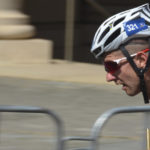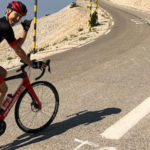By Ron Berry, PT
The Santa Barbara 100, with its options of rides: 34 miles, 62 miles ( a metric Century), 62 miles with the “Gibraltar Challenge,” and 100 miles including the Gibraltar Challenge, is 6 weeks away. Several of the staff and clientele at PHASE IV have decided that participating in the event at any level is a healthy and fun way to experience Santa Barbara and build our fitness as we peak for October 19. With 4 options on race day, Ride Santa Barbara offers something for everyone.
The 34 mile ride sounds like anyone with a moderate level of fitness and 6 weeks of more specific training could accomplish. All 4 of the options will be rolling through the lovely neighborhoods of Santa Barbara and Montecito and ending at Ledbetter Beach for a beer garden lunch in the park. Hopefully, the 34 mile folks don’t eat up all the buffet the longer distance riders will be needing to replenish some calories. That’s actually not a real worry. The Santa Barbara 100 organizers seem to know what they’re doing. The website’s well organized and it truly seems like it will all work out well.
I have chosen to aim for the Metric Century with the Gibraltar Challenge. The Gibraltar Challenge is a separately timed section of the ride. 25 miles in, that climb increases 3,000 feet over 7 miles.
The weekend of October 19th has been cleared. Lodging near Ledbetter Beach has been scouted. And, most importantly, an Aerobic Base and Structural Integrity has been worked on.
About 3 months ago when I decided to do the Ride Santa Barbara Metric Century with the big climb, I had to first figure out what my aerobic threshold was by doing a VO2 Test at PHASE IV.
I knew that to enjoy a 4-6 hour bike ride I would have to develop my physiological infrastructure to be more efficient at using stored fat as fuel. Based on my specific data from the VO2 test analysis, I learned that I must concentrate on working out with my heart rate in the mid 130s. At this heart rate I would build my metabolic efficiency, meaning: develop my ability to use fat as fuel. Also, at that intensity my muscles would be able to adapt to the stress of training through a process called vascularization: increasing the number of vessels that carry oxygen and glycogen to my muscles more efficiently. These are the systems that endurance athletes rely on, and the reason why some of us “bonk,” cramp, and miss the finish line. Working too hard too soon in the wrong heart rate zone causes the muscular and metabolic systems to shut down short of the finish line.
Then, just as I was satisfied with my metabolic training, disaster struck. I incurred an upper extremity bowling injury that made it painful to be training on my road bike; and, in fact, a little dangerous to be on the road bike too. Even though my bowling score was higher than my base training heart rate zone, that night of fun, strikes and spares included, just wasn’t worth it. Being a physical therapist I knew I had to get off the road bike. Unfortunately, like a lot of people, I really struggle doing hour long, low intensity rides on bikes that aren’t actually moving. So, I got into some cross training. (Please refer to my last article about base training)
I couldn’t do my favorite summer cross training of swimming in the ocean because of my bowlers biceps tendonitis. Instead, I went on several long hikes in the Santa Monica mountains. I also worked on developing my Structural Integrity, meaning I emphasized stretching and doing some light resistance training for my hips and thighs. Even after 2 weeks of training every other day doing the PHASE IV hip and thigh exercises in the Forster Structure Program, using elastic bands and light weights, I felt much stronger. My shoulder was healing (lots of icing, isometrics, massage, and proper sleep positioning), and this allowed me back onto the bike. The two week rehab forced a recovery and I felt even better than before my training got interrupted.
It only took a few 90 minute rides at heart rates between 130 and 150 to keep my exertion levels steady. Also, I wasn’t especially hungry nor tired, nor sore, at the end of my rides. Positive signs that my base training was working. The cross training worked and my recreational level of fitness had continued to improve during my period of shoulder rehabilitation.
I’m still working on my flexibility, trunk strengthening, and recovering from my shoulder injury. But, in the past few weeks I’ve begun more specifically addressing the matter of this 3,000 feet of climbing in 7 miles. Although, I am still working on increasing my long distance rides at least once a week, recently, my PHASE IV Coaching plan has had me doing some short hill repeats in my “aerobic conditioning” zones in the mid 150s. I’ve also started doing some of the longer climbs in the area, Encinal Canyon, and, to the top of the Palisades Highlands. The next few weeks will see me getting up, down, and around Yerba Buena Road, and Latigo Canyon.
I’ve purposely built up my return to riding in the mountains slowly, and progressively, so that my body would be allowed to adapt and garner the future benefits of the base training, both on the physiological and musculoskeletal levels. I want to be resilient enough to focus on recovery after each ride. It is recovery from exertion where fitness is built; not during the rides. Time spent in recovery also helps avoid an overuse injury. I want to have the energy to be able to do multiple rides during a busy professional work schedule. A methodical training plan takes all the guess work out of achieving the necessary training to sustain me to the finish line. I just need to keep working with the program, eating healthy, enjoying myself, and, stay away from bowling.
If you are interested in doing this event but are hesitating, please don’t let a lack of confidence in your fitness, or fear of injury, hold you back from experiencing any one of these glorious rides! Call or email Shelby and schedule a free fitness consultation to help choose which ride is best for you, and get your VO2 so that you will know exactly what heart rates to train and ride in, especially on race day. Crossing the finish line in good form is the reward a training smart.
Preparing for any one of these rides requires a daily plan, and that is what PHASE IV does best. We’ll put together a heart rate training plan complete with time, distance, and intensity, as well as your nutrition and hydration plan from now through race day on October 19.
If you are interested in joining us, but have questions, please reach out today. The early registration period ends September 15, after which they raise the registration price. Group participants enjoy an additional discount on their registration fees as well.
Give us a call and we’re off to the races!
310-582-8212







